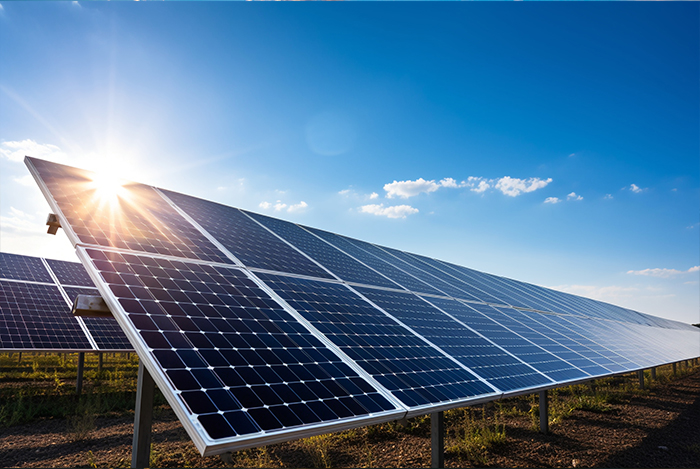Solar panel mount bracket is an important part of the solar photovoltaic system, equivalent to the skeleton of the system plays the role of carrying and holding photovoltaic panels, the appropriate installation can make it to achieve the maximum efficiency of the photovoltaic system power generation.
The main materials of the solar bracket are aluminum alloy, carbon steel, galvanized magnesium aluminum, etc., of which aluminum alloy is the most widely used due to its lightweight, cost-effective, corrosion-resistant and other excellent features.
The components of the bracket system are: rails, clamps, screws and other components, through the interconnection of photovoltaic panels to the optimal angle fixed to the building structure to ensure the stability of the system installed on the building structure, good performance of wind and snow resistance, when choosing the photovoltaic bracket, buyers need to communicate with the manufacturer, take into full account the project location of the wind speed, snow load, the angle of the direction, roof materials, beam spacing and other factors, in order to customize the most suitable and safest bracket program!
6 types of solar panel mounting system
Roof Mounting (Tile)
1. Roof mounting can maximize the effective use of space
Roof mounting can maximize the use of space without taking up additional land for the homeowner to fully utilize the light into energy.
2. Overall aesthetics
The rails are fixed to the roof tiles and beams, and then the PV panels are fixed with clamps, screws and other accessories. After installation, the bracket is not even visible from the front, and the overall aesthetics is simple.
3. Low cost and cost-effective
Compared to other installation methods, tile roofing requires the least amount of materials and has the lowest cost. It is also easy to maintain.
4. Low energy loss
The DC side of a roof-mounted system has a short distance, and energy loss is often minimized.
5. Convenient daily operation and maintenance
Roof-mounted photovoltaic is not easy to accumulate dust, easy to clean and take care of daily, the roof is easy to reach the artificial, easy to check the daily maintenance, saving labor costs.
Attention should be paid to the orientation and shading factors when installing photovoltaic mounts.
Roof Mounting (flat Cement roof)
In addition to the same advantages as tile roof mounting
Cement flat roof mounted PVs usually need to be fixed and secured by rails, triangular supports, concrete piers, etc. As the temperature underside of the PV panels is lower, it is possible to utilize the rooftop area to build a sunshade, which is conducive to lowering the temperature of the penthouse in the summer, and to adjust the mounting angle by means of a bracket so that it is vertical to the sunlight by 90 degrees, thus improving the daily power generation efficiency.
Ground Mounting (Concrete Floor)
Similar to a flat concrete roof, a concrete floor installation requires rails, triangular supports, and concrete piers. Some developed areas with high labor costs will also take the die-casting bracket program, with 2 folded tripod support open on the ground to form a certain angle of support. And with cement piers or stones, sandbags and other heavy objects ballasted on the bottom edge to ensure stability!
It should be noted that, in densely populated areas of the ground installation is difficult to avoid buildings, trees, and easy to accumulate dust, need to be cleaned often!

Ground Installation (Mountain)
Mountain projects usually need to be based on the soil conditions of the land to play spiral nails, etc., and can be combined with eco-agriculture planting, making full use of mountainous land, the formation of agro-photovoltaic projects.
It usually suitable for large-scale centralized PV projects
Floating Mounting system
Floating bracket is usually made of internal hollow HDPE plastic floating block connected to play a supporting role, PV panels can be utilized to generate electricity in the water surface space, suitable for land area is limited, but the need to install photovoltaic areas.

Floating bracket is mostly used in ponds, lakes, oceans and other horizontal relatively static area, does not occupy the land area, and he can effectively reduce the evaporation of water from the lake, etc., part of the floating bracket can withstand 10 meters of sea waves, but most of the floating projects need to be installed in the relatively static water surface.
Solar Tracking Bracket
Tracking bracket is one of the more popular installation methods in recent years, tracking bracket is different from the traditional fixed bracket,it can follow the sun's angle of movement changes, timely adjustment of the angle of the PV panels are always kept perpendicular to the direction of the sun, to avoid the sun because of the passage of time and the shadow generated by the impact of power generation, so as to achieve the maximization of PV panels of the power generation.
But the cost of tracking bracket than the traditional column bracket to a high, but also has a certain failure rate, so in the choice of time need to be integrated in all aspects of consideration!
In a word, the choice of PV bracket depends largely on the area of the project site and the situation to choose the optimal installation method, LESSO solar is the company with a wealth of experience in production, installation of photovoltaic companies, customers can provide site drawings and other information, free access to the project bracket installation of the detailed planning drawings and budget checklist table, if you have any questions you can also leave a message to us, our technical team will do our best to help you.







